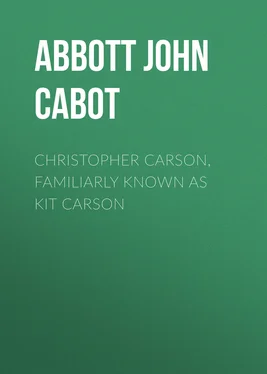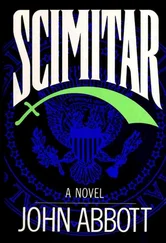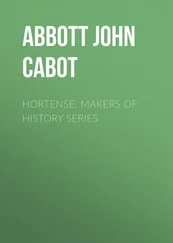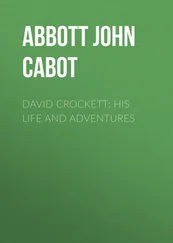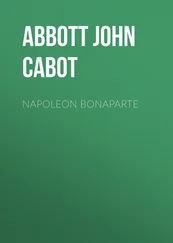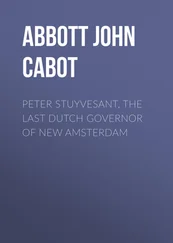John Abbott - Christopher Carson, Familiarly Known as Kit Carson
Здесь есть возможность читать онлайн «John Abbott - Christopher Carson, Familiarly Known as Kit Carson» — ознакомительный отрывок электронной книги совершенно бесплатно, а после прочтения отрывка купить полную версию. В некоторых случаях можно слушать аудио, скачать через торрент в формате fb2 и присутствует краткое содержание. Жанр: foreign_prose, История, foreign_edu, foreign_antique, на английском языке. Описание произведения, (предисловие) а так же отзывы посетителей доступны на портале библиотеки ЛибКат.
- Название:Christopher Carson, Familiarly Known as Kit Carson
- Автор:
- Жанр:
- Год:неизвестен
- ISBN:нет данных
- Рейтинг книги:3 / 5. Голосов: 1
-
Избранное:Добавить в избранное
- Отзывы:
-
Ваша оценка:
- 60
- 1
- 2
- 3
- 4
- 5
Christopher Carson, Familiarly Known as Kit Carson: краткое содержание, описание и аннотация
Предлагаем к чтению аннотацию, описание, краткое содержание или предисловие (зависит от того, что написал сам автор книги «Christopher Carson, Familiarly Known as Kit Carson»). Если вы не нашли необходимую информацию о книге — напишите в комментариях, мы постараемся отыскать её.
Christopher Carson, Familiarly Known as Kit Carson — читать онлайн ознакомительный отрывок
Ниже представлен текст книги, разбитый по страницам. Система сохранения места последней прочитанной страницы, позволяет с удобством читать онлайн бесплатно книгу «Christopher Carson, Familiarly Known as Kit Carson», без необходимости каждый раз заново искать на чём Вы остановились. Поставьте закладку, и сможете в любой момент перейти на страницу, на которой закончили чтение.
Интервал:
Закладка:
Such were the perils upon which the youthful Kit Carson was now entering from the pure love of adventure. He was not uninformed respecting these dangers. The knowledge of them did but add to the zest of the enterprise.
Crossing the plains of the interior of our Continent from the Missouri river to the Rocky mountains, was a very different undertaking half a century ago, from what it has been in more modern times. The route was then almost entirely unexplored. There were no charts to guide. The bold adventurers knew not where they would find springs of water, where forage for their animals, where they would enter upon verdureless deserts, where they could find fording-places of the broad and rapid rivers which they might encounter on their way.
This is not a forest-covered continent. The vast plains of the interior, whether smooth or undulating or rugged, spread far away for weary leagues, almost treeless. The forest was found mainly skirting the streams. Immense herds of buffaloes, often numbering ten or twenty thousand, grazed upon these rich and boundless pastures. Timid deer and droves of wild horses, almost countless in numbers, here luxuriated in a congenial home. There was scarcely a white man in the land whose eyes had ever beheld the cliffs of the Rocky mountains. And each Indian tribe had its hunting-grounds marked out with considerable precision, beyond which even the boldest braves seldom ventured to wander.
About a score of men started upon this trip. They were thoroughly armed, practiced marksmen, well mounted and each man led a pack mule, heavily laden with goods for the Santa Fe market. Their leader was commander-in-chief, whom all were bound implicitly to obey. He led the company, selecting the route, and he decided when and where to encamp. The procession followed usually in single file, a long line.
Early in the morning, at the sound of the bugle, all sprang from their couches which nature had spread, and they spent no more time at their toilet than did the horse or the cow. After a hurried breakfast they commenced their march. Generally an abundance of game was found on the way. The animals always walked slowly along, being never put to the trot.
At noon the leader endeavored to find some spot near a running stream or a spring, where the animals could find pasture. The resting for a couple of hours gave them time for their dinner, which they had mainly picked up by the way.
An hour or two before sundown the camping ground was selected, the animals were tethered, often in luxuriant grass, and the hardy pioneers, by no means immoderately fatigued by the day's journey, having eaten their supper, which a good appetite rendered sumptuous, spent the time till sleep closed their eyelids in telling stories and singing songs. A very careful guard was set, and the adventurers enjoyed sound sleep till, with the dawn, the bugle call again summoned them. Under ordinary circumstances hardy men of a roving turn of mind, found very great attractions in this adventurous life. They were by no means willing to exchange its excitements for the monotonous labors of the field or the shop.
CHAPTER II.
Life in the Wilderness
A Surgical Operation.—A Winter with Kin Cade.—Study of the Languages and Geography.—Return towards Missouri.—Engagement with a new Company and Strange Adventures.—The Rattlesnake.—Anecdote of Kit Carson.—The Sahara.—New Engagements.—Trip to El Paso.—Trapping and Hunting.—Prairie Scenery.—The Trapper's Outfit.—Night Encampment.—Testimony of an Amateur Hunter.
The company of traders which Kit had joined enjoyed, on the whole, a prosperous expedition. They met with no hostile Indians and, with one exception, encountered nothing which they could deem a hardship. There was one exception, which most persons would deem a terrible one. The accidental discharge of a gun, incautiously handled, shattered a man's arm, shivering the bone to splinters. The arm rapidly grew inflamed, became terribly painful, and must be amputated or the life lost. There was no one in the party who knew anything of surgery. But they had a razor, a handsaw and a bar of iron.
It shows the estimation in which the firm, gentle, and yet almost womanly Kit Carson was held, that he was chosen to perform the operation. Two others were to assist him. The sufferer took his seat, and was held firmly, that in his anguish his struggles might not interfere with the progress of the knife. This boy of but eighteen years then, with great apparent coolness, undertook this formidable act of surgery.
He bound a ligature around the arm very tightly, to arrest, as far as possible the flow of blood. With the razor he cut through the quivering muscles, tendons and nerves. With the handsaw he severed the bone. With the bar of iron, at almost a white heat, he cauterized the wound. The cruel operation was successful. And the patient, under the influence of the pure mountain air, found his wound almost healed before he reached Santa Fe.
Having arrived at his journey's end, Kit's love of adventure led him not to return with the traders, by the route over which he had just passed, but to push on still further in his explorations. About eighty miles northeast of Santa Fe there was another Spanish settlement, weird-like in its semi-barbarous, semi-civilized aspects, with its huts of sun-baked clay, its Catholic priests, its Mexican Indians and its half-breeds. It was a small, lonely settlement, whose population lived mainly, like the Indians, upon corn-meal and the chase. Kit ever kept his trusty rifle with him. His gun and hatchet constituted his purse, furnishing him with food and lodging.
It was a mountainous region; here in one of the dells, Kit came across the solitary hut of a mountaineer by the name of Kin Cade. They took a mutual liking to each other. As Kit could at any day, with his rifle bring in food enough to last a week, the question of board did not come into consideration. It was in the latter part of November that Kit first entered the cabin of this hunter. Here he spent the winter. His bed consisted probably of husks of corn covered with a buffalo robe, a luxurious couch for a healthy and weary man. Pitch pine knots brilliantly illumined the hut in the evening. Traps were set to catch animals for their furs. Deer skins were softly tanned and colored for clothing, with ornamental fringes for coats and leggins and moccasins. Kit and his companion Kin were their own tailors.
Thus passed the winter of 1826. Both of the men were very good-natured, and of congenial tastes. They wanted for nothing. When the wind howled amid the crags of the mountains and the storm beat upon their lonely habitation, with fuel in abundance and a well filled larder, and with no intoxicating drinks or desire for them, they worked upon their garments and other conveniences in the warmth of their cheerful fireside. It is not hazarding too much to say that these two gentle men, in their solitary cabin, passed a far more happy winter than many families who were occupying, in splendid misery, the palatial residences of London, Paris and New York.
Kin Cade was perhaps a Spaniard. He certainly spoke the Spanish language with correctness and fluency. The intelligence of Kit is manifest from the fact that he devoted himself assiduously during the winter to the acquisition of the Spanish language. And his strong natural abilities are evidenced in his having attained, in that short time, quite the mastery of the Spanish tongue. It is often said that Kit Carson was entirely an uneducated man. This is, in one respect, a mistake. The cabin of Kin Cade was his academy, where he pursued his studies vigorously and successfully for a whole winter, graduating in the spring with the highest honors that academy could confer.
We ought not to forget that, in addition to the study of the languages, he also devoted much attention to the study of geography. They had no books, no maps. It is doubtful indeed, whether either Kit or his teacher could read or write. But Kin had been a renowned explorer. He had traversed the prairies, climbed the mountains, followed the courses of the rivers, and paddled over the lakes. With his stick he could draw upon the smoothly trodden floor of his hut, everything that was needful of a chart. There were probably many idle students in Harvard and Yale, who during those winter months did not make as much intellectual progress as Kit Carson made.
Читать дальшеИнтервал:
Закладка:
Похожие книги на «Christopher Carson, Familiarly Known as Kit Carson»
Представляем Вашему вниманию похожие книги на «Christopher Carson, Familiarly Known as Kit Carson» списком для выбора. Мы отобрали схожую по названию и смыслу литературу в надежде предоставить читателям больше вариантов отыскать новые, интересные, ещё непрочитанные произведения.
Обсуждение, отзывы о книге «Christopher Carson, Familiarly Known as Kit Carson» и просто собственные мнения читателей. Оставьте ваши комментарии, напишите, что Вы думаете о произведении, его смысле или главных героях. Укажите что конкретно понравилось, а что нет, и почему Вы так считаете.
